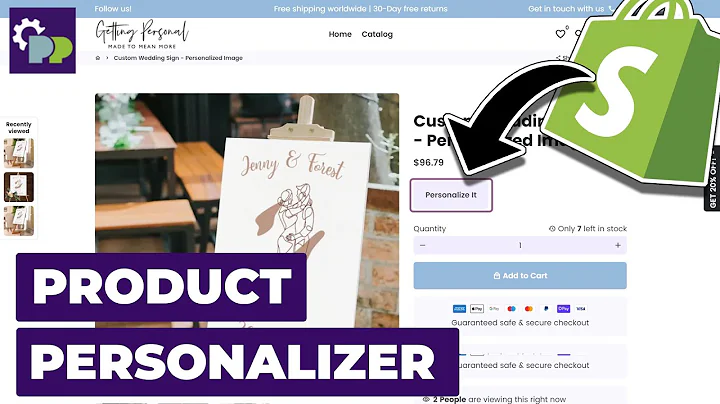Maximizing Your Blog's Potential in Shopify
Table of Contents
- Introduction to Blog Functionality in Shopify
- How Blogs Work in the Admin
- Managing Blogs in Shopify
- Setting up a New Blog
- Creating and Managing Blog Posts
- Adding SEO Controls to Blog Posts
- Displaying Blog Posts on the Storefront
- Adding Blog Links to the Main Menu
- Exploring the Blog.liquid Template
- Customizing Blog Templates with Article.liquid
- Creating Specific Templates for Different Blog Types
- Enhancing Blogs with Comments
- Additional Resources and Support
- Conclusion
Introduction to Blog Functionality in Shopify
In this article, we will explore the blog functionality in Shopify and how it can be leveraged to improve your online store. Blogs are an essential part of any content marketing strategy as they allow you to share valuable information, engage with your audience, and drive traffic to your store. We will take a closer look at how blogs work within the Shopify admin and how you can customize the blog templates to create a unique and engaging experience for your customers.
How Blogs Work in the Admin
Before diving into the templates, it's important to understand how blogs work within the Shopify admin. Blogs in Shopify act as containers for content related to specific themes or topics. You can have multiple blogs within Shopify, each serving a different purpose or target audience. In the admin, you can manage and organize your blog posts, set SEO controls, and customize the display settings for each blog.
Managing Blogs in Shopify
In the admin navigation, you will find a section called "Blog Posts" where all your blog posts are listed. Within this section, you can manage your blogs, create new blogs, and add new blog posts. Blogs can have unique URLs, comments can be enabled or disabled, and SEO controls can be set to optimize each blog for search engine visibility.
Setting up a New Blog
To set up a new blog, you need to navigate to the "Manage Blogs" section within the admin. Here, you can create a new blog and provide a title, URL handle, and other settings. The handle determines the URL structure for all the posts within that specific blog. You can also enable or disable comments for your blog, set SEO controls like meta tags and descriptions, and customize the blog's appearance.
Creating and Managing Blog Posts
Once you have set up your blog, you can start creating and managing blog posts. Within the "Blog Posts" section, you can add new posts, edit existing ones, and organize them by date, tags, or other criteria. Each blog post can have a title, content, author information, and tags for categorization. You can also set the publish date, add SEO controls, and preview the post before making it live.
Adding SEO Controls to Blog Posts
Similar to pages and products, blog posts in Shopify have SEO controls that allow you to optimize their visibility on search engines. You can set the page title, description, and other meta tags to improve your blog post's ranking and visibility. These SEO settings play a crucial role in attracting organic traffic to your blog and ultimately to your online store.
Displaying Blog Posts on the Storefront
To display your blog posts on the storefront, you need to customize the blog templates. Within the Shopify theme editor, you can access the "Templates" folder and find the "blog.liquid" file. This file controls the layout and styling of the main blog page that lists all the blog posts. By modifying this template, you can create a visually appealing and user-friendly blog listing page.
Adding Blog Links to the Main Menu
To make your blog easily accessible to visitors, you can add blog links to the main menu of your store. In the "Navigation" section of the admin, you can create a new link for your blog and specify the blog type or category. By adding this link to the main menu, customers can quickly navigate to your blog and explore the latest posts.
Exploring the Blog.liquid Template
The "blog.liquid" template is responsible for rendering the blog listing page on the storefront. This template includes a loop that iterates over all the blog posts and displays them in a formatted list. You can customize this template to match your store's branding and design preferences. It allows you to output the blog title, post URLs, and other relevant information.
Customizing Blog Templates with Article.liquid
For individual blog posts, Shopify uses the "article.liquid" template. This template controls the layout and styling of a single blog post page. By editing the "article.liquid" template, you can customize the appearance of individual blog posts, including the title, publication date, content, and any additional elements you want to include.
Creating Specific Templates for Different Blog Types
To further tailor the appearance of your blog posts, you can create specific templates for different blog types. By duplicating the "article.liquid" template and adding a unique identifier, such as "video," you can create specialized templates for specific types of blog posts. This customization allows you to present different types of content in unique and engaging ways.
Enhancing Blogs with Comments
Shopify's blog functionality includes the option to enable comments on your posts. Comments can facilitate engagement and create a sense of community around your blog. By allowing customers to leave comments and participate in discussions, you can build relationships and gather valuable feedback. You can explore the Shopify documentation for more information on how to enable and manage comments.
Additional Resources and Support
If you have any questions or need assistance with blog templates or any other Shopify-related topic, you can find additional resources and support on the Shopify documentation website. Visit docs.shopify.com/themes for comprehensive guides, tutorials, and troubleshooting tips. You can also reach out to the Shopify support team via email or Twitter for personalized assistance.
Conclusion
Blogging is an effective way to connect with your audience, showcase your expertise, and drive traffic to your online store. With Shopify's flexible blog functionality, you can create engaging and visually appealing blog posts that align with your brand. By customizing the blog templates, optimizing SEO settings, and utilizing comments, you can maximize the impact of your blog and attract more visitors to your store. Keep exploring and experimenting with different blog strategies to enhance your online presence and grow your business.













